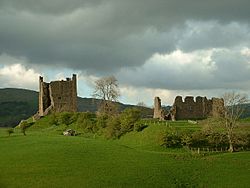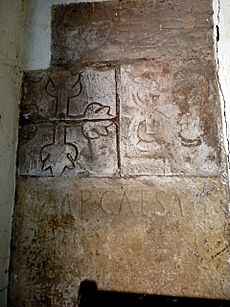Verterae facts for kids
Quick facts for kids Verterae |
|
|---|---|
| Brough, Cumbria, England | |

Part of the Roman earthworks, incorporated into the later Brough Castle.
|
|
| Coordinates | 54°31′34″N 2°19′06″W / 54.52611°N 2.31833°W |
| Type | Castra |
| Site information | |
| Condition | Earthworks only survive |
| Site history | |
| Built | 1st century AD |
Verterae was an important Roman fort located in what is now the village of Brough, Cumbria, England. It was used by the Romans for many years, from the 1st century AD to the 5th century AD. This fort helped protect a major Roman road in northern England. Later, in the 11th century, Brough Castle was built right on top of some of the old Roman fort by the Normans. Today, archaeologists have explored the remains of Verterae, and it is now a protected historical site in the UK.
Contents
What Does the Name Verterae Mean?
The name Verterae, sometimes called Verteris, comes from an old British language called Common Brittonic. It likely means "the Forts" or "high places." This name makes a lot of sense because Verterae was indeed a fort built in a high area. Other places in Scotland, like Ferter and Fortriu, might have names that come from the same old word.
Life at the Roman Fort
Verterae was probably built by a Roman leader named Gnaeus Julius Agricola around AD 79-80. He was trying to take control of northern Britain. The fort was a key stop on a main Roman road. This road connected the Roman towns of Luguvalium (modern-day Carlisle) and Eboracum (modern-day York).
Why Was Verterae So Important?
Roman forts were usually built every 12 to 14 miles along important roads. Verterae was one of these forts. It helped protect the Stainmore Pass, a mountain route that goes from the River Eden across the Pennines mountains. Even today, this route is still a major road, carrying the A66 across the Pennines.
What Did the Fort Look Like?
The fort was shaped like a rectangle and covered about 3 acres of land. It was built on a ridge, which is a raised strip of land, overlooking a stream called Swindale Beck. Because other buildings were built on top of it later, it's hard to know the exact size of the fort. But it might have been about 100 by 110 meters across. It also had a ditch around it that was up to 15 meters wide and 6 meters deep in some places.
Outside the main fort, there was a small settlement called a vicus. This was where civilians, like families of soldiers or traders, lived. There was also a cemetery nearby. The buildings in the vicus were made from stone or from wood and mud.
Who Lived at the Fort?
Around the late 4th century and early 5th century, a special group of Roman soldiers called the Numerus Directorum were stationed at Verterae. This unit had about 300 to 400 soldiers. They helped keep the area safe and the roads open.
After the Romans Left

The Roman fort of Verterae was still used for a while after the Romans left Britain around the year 410 AD. But eventually, it was abandoned and fell into ruin.
How Was Verterae Rediscovered?
In the 11th century, a Norman castle was built right inside the old, ruined walls of the Roman fort. Many years later, in the 16th century, a historian named William Camden figured out that the place then called Brough was actually the old Roman fort of Verterae.
In the mid-1800s, old Roman items were found at the site. Then, in 1923, the government started digging to learn more about the fort. More digs happened in 1954, and again in the 1970s and 1990s. A full study of the site was done in 1996. Today, the area where the fort was, including the medieval castle and nearby lands, is protected by UK law as a Scheduled Ancient Monument. This means it's a very important historical site that needs to be preserved.

